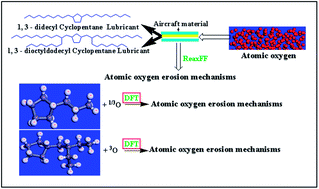Theoretical investigation of atomic oxygen erosion mechanisms of 1,3-didecyl cyclopentane, 1,3-dioctyldodecyl cyclopentane and alkylated cyclopentane†
Abstract
The micro erosion processes of atomic oxygen for 1,3-didecyl cyclopentane and 1,3-dioctyldodecyl cyclopentane lubricants have been investigated by using a Reaxff molecular dynamics method. Simulation results showed that the creation of H2, CO, and CO2 is the main reason for the quality loss of lubricants. O-atom addition and H abstraction are the main mechanisms. Furthermore, singlet and triplet atomic oxygen erosion mechanisms for two kinds of alkylated cyclopentanes have been investigated utilizing density functional theory (DFT) methods. DFT calculation demonstrated that different spin states of atomic oxygen correspond to different erosion mechanisms, and no non-adiabatic reaction phenomenon appears. Alkylated cyclopentanes are damaged by insertion of triplet oxygen atoms among the C–C bonds, the branched chain in alkylated cyclopentane is easier to be removed due to the lower activation barrier. Erosion products are H, CO, CO2, and CH2O, organic oxygen radicals are the main intermediates in the 3O erosion process. However, 1O erosion originates from the elimination mechanism and the extent of lubricant degradation is lower. Finally, the diffusion coefficient of atomic oxygen in 1,3-didecyl cyclopentane is 1.63 times that of 1,3-dioctyldodecyl cyclopentane, which is the fundamental reason for the 1,3-dioctyldodecyl cyclopentane having better atomic oxygen resistance performance.


 Please wait while we load your content...
Please wait while we load your content...